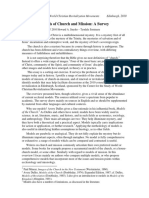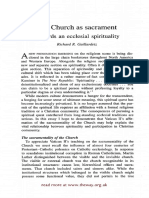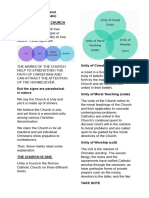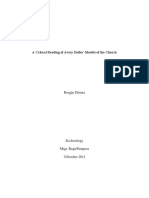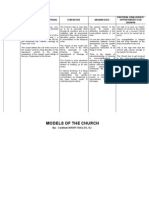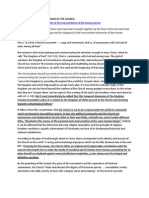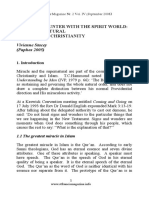The Paradigms/Models of the Church
Introduction
Understanding the various images or paradigms of the church is a crucial endeavor,
especially when considering its relevance to mission. The church, throughout history, has been
depicted and understood in diverse ways, each carrying distinct implications for its role and
purpose.
By delving into these paradigms, we not only gain insights into the evolving nature of the
church but also grapple with questions of identity and mission. The images of the church serve as
windows into the beliefs and values of different communities, reflecting how they perceive their
role in the world and their mission within it.
This exploration is relevant to mission in several ways. Firstly, it allows us to appreciate
the richness and diversity of the Christian tradition. Each paradigm brings forth unique
perspectives on the purpose of the church, shedding light on the multifaceted nature of its mission.
Embracing this diversity fosters a more inclusive and holistic understanding of what it means to
engage in mission work.
Secondly, a nuanced understanding of these paradigms equips individuals and
communities with the ability to adapt their approach to mission in different contexts. Recognizing
that there isn't a one-size-fits-all model for mission work, being familiar with various church
paradigms provides a toolkit for navigating the complexities of a rapidly changing world.
Moreover, delving into the images of the church enables us to critically examine our own
perspectives and biases. It challenges us to reconsider assumptions about mission and encourages
a thoughtful and reflective approach to our roles within the broader context of the church.
In essence, the study of church paradigms is not just an academic exercise; it's a journey
into the heart of what it means to be a community of believers on a mission. It invites us to engage
in a meaningful dialogue about the essence of the church and its purpose in the world, laying a
foundation for more intentional and informed mission endeavors.
Church as Institution
The institutional view defines the Church primarily in terms of its visible structures,
especially the rights and powers of its officers. It is a hierarchical form of Church government,
which the Robert Bellarmine, SJ (1542-1621), described as a society “as visible and palpable as
the community of the Roman people, or the Kingdom of France, or the Republic of Venice.” Thus,
authority is vested in the ruling class –clerics and church officers – whose jurisdiction is patterned
after the secular state. As agents of God’s sacraments, the priesthood opens and shuts the valves
of divine grace. Because the institutional model maintains that its hierarchical structure belongs to
1
�the apostolic deposit passed down by Christ’s disciples, the authority of the ruling class is regarded
as God-given, and should therefore be unquestionably accepted by the faithful.
The strength of the Institutional model is in its public, visible manifestation of solidarity.
It presents a tangible communion of faith. Unlike the other models, all tests of membership are
visible and demonstrable. The weaknesses of this model, however, are also significant. On its own,
it may become rigid, doctrinaire, and conformist; it could easily substitute the official Church for
God, and this would be a form of idolatry.
Church as Mystical Communion
According to this perspective, the church consists of faithful men and women who are
bound together by their participation in God’s Spirit through the living Christ. The nature of this
unity is not institutional but pneumatological, communal, and personal. The goal of the Church, in
this second ecclesiological type, is a spiritual or supernatural one. The Church aims to lead men
into communion with the Divine. The Church, from this point of view, is not in the first instance
an institution or a visibly organized society. Rather it is a communion of men, primarily interior
but also expressed by external bonds of creed, worship, and ecclesiastical fellowship” The bond
of unity, in this model, consists of the gifts of the Holy Spirit, though the external bonds are
recognized as important in a subsidiary way.
The strength of the Church as Mystical Communion is its emphasis on the dynamic
community generated by the Holy Spirit along a vertical line (relationship with God) and
horizontally (relationship with brother and sisters). The potential downside of this model is the
danger of it degenerating into mere Christian fellowship without objective theological content. As
one historian/ theologian said (Avery Dulles) “the communion may exalt and divinize the Church
beyond its due, it may also fail to give Christians a clear sense of their identity and mission.
Church as Sacrament
In a sense, this model seeks to bring the previous two (Institutional and Mystical
Communion) closer together, retaining structure while also promoting dynamic spiritual life. It is
predicated on the notion that the structure of human life is symbolic. “The body with all its
movements and gestures becomes the expression of the human spirit. The spirit comes to be what
it is in and through the body”. Accordingly, the Church as sacrament is a sign and transmitter of
God’s grace in the world. As an embodiment of the grace that it signifies, the Church exists as the
presence of God to the nations.
Another important element of this model highlights and affirms that the sacrament are
communal realities and not individual transactions:
As understood in the Christian tradition, sacraments are never merely individual
transactions. Nobody baptizes, absolves, or anoints himself, and it is anomalous for the Eucharist
to be celebrated in solitude. Here again the order of grace corresponds to the order of nature. Man
comes into the world as a member of a family, a race, a people. He comes to maturity through
encounter with his fellow men. Sacraments therefore have a dialogic structure. They take place in
2
�a mutual interaction that permits the people together to achieve a spiritual breakthrough that they
could not achieve in isolation. A sacrament therefore is a socially constituted or communal
symbol of the presence of grace coming to fulfillment.
The strength of this model is that the church truly is a sign and instrument of grace to its
members and to the world, while seeking to hold in tension of the outer
(organizational/institutional) and inner (mystical communion) aspects of the Church. Dulles
indicates that its weakness is that it has little warrant in Scripture and in the early tradition of the
Church and that it “could lead to a sterile aestheticism and to an almost narcissistic self-
contemplation”.
Church as Herald
If the previous model is least common among Protestants, this one is probably the most
widely accepted. The herald model “differs from the preceding because it makes the ‘word’
primary and the ‘sacrament’ secondary. It sees the Church as gathered and formed by the word
of God. The mission of the Church is to proclaim that which it has heard, believed, and been
commissioned to proclaim”. This model is kerygmatic, for it looks upon the Church as a herald –
one who receives an official message with the commission to pass it on. The basic image is that of
the herald of the king who comes to proclaim a royal decree in a public square. At the center of
the heralding church is the activity of calling its members to renewal and reformation.
The strength of this model is its emphasis on the message of the gospel and the pursuit
of the Great Commission. It can be limited, however, in that it is often devoid of incarnational
service. This truncation, in its most acute form, can appear docetic—merely ideas without
tangible reality. This is especially obvious when “it focuses too exclusively on witness to the
neglect of action. It is too pessimistic or quietistic with regard to the possibilities of human effort
to establish a better human society in this life, and the duty of Christians to take part in this common
effort.
Church as Servant
The servant model “asserts that the Church should consider itself as part of the total
human family, sharing the same concerns as the rest of men”. Following in the footsteps of
Jesus our Lord, the Suffering Servant, “[T]he Church announces the coming of the Kingdom not
only in word, through preaching and proclamation, but more particularly in work, in her ministry
of reconciliation, of binding up wounds, or suffering service, of healing…. And the Lord was the
‘man for others,’ so must the Church be ‘the community for others’”
In explicating the precise meaning of “Church as Servant,” Dulles notes, “The term
“servant,” indeed, contains certain ambiguities. It connotes three things: work done not freely but
under orders; work directed to the good of others rather than to the worker’s own advantage; and
work that is humble and demeaning. The weakness of the Servant model is observed in the work
of its theologically liberal adherents, men such as John A. T. Robinson and Harvey Cox, for
example. These proponents of so called “secular theology” have challenged us to think about the
3
�role of the church in the world, but, tragically, they have compromised the biblical deposit of faith
which Christians are called to guard.








